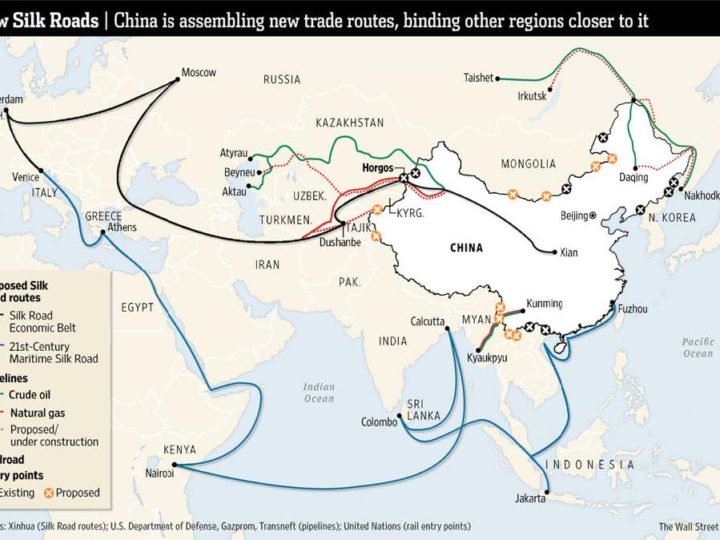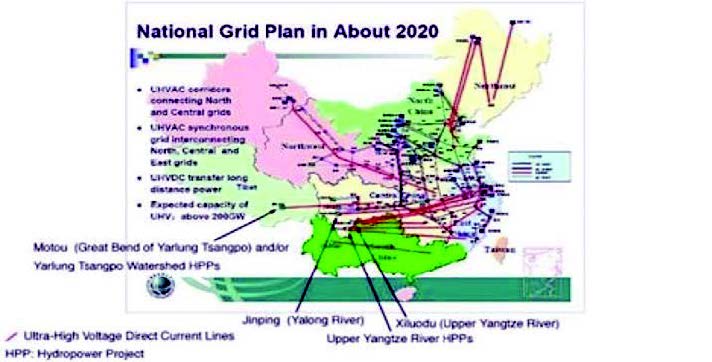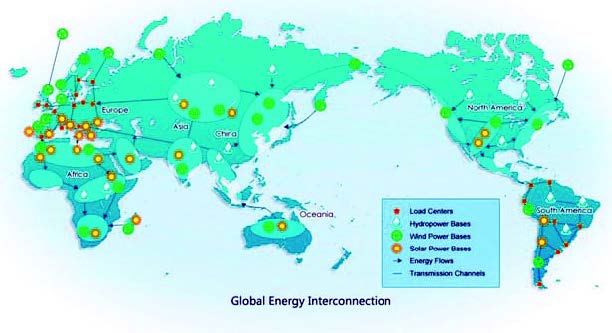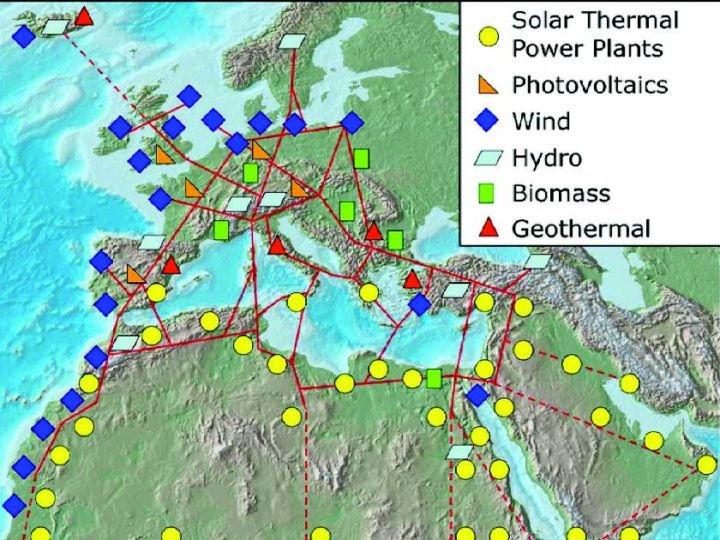The study was promoted by State Grid Corporation of China (SGCC), the largest electric utility company in the world, in order to “meet global energy demands while promoting the development of green and alternative solutions.”
The feasibility study was carried out by Global Energy Interconnection Development and Cooperation Organization (GEIDCO), set up by SGCC in March 2016. Since then, GEIDCO has been joined by over 260 businesses and scientific institutions from 22 countries in Africa, Asia, Europe, North and South America, and Oceania. The former SGCC President Liu Zhenya is the chairman of GEIDCO and a Nobel Prize in Physics recipient, as well as the former US Secretary of Energy under the Obama administration, Steven Chu, serves as GEIDCO’s vice chairman.
Global Energy Interconnection to be the backbone of decarbonisation
The aim of GEIDCO is to promote the worldwide interconnection of power grids by 2050 in order to optimise the use of electricity coming from every power plant on the planet, employing supercritical UHV (ultra-high voltage) lines for fast, long-distance power transmission as well as smart grids to boost end-use efficiency.
GEI could be the backbone of a decarbonised world economy thanks to the full exploitation of renewables and clean technologies.
UHV grid continuity coupled with increased storage capacity of hydro, solar, and wind energy will enable quicker distribution of power from renewables, even when it is generated in remote areas or when local supply exceeds local demand, such as in Italy or Germany.
In other words, energy from renewables in Tibet, the Sahara Desert, the North Sea, southern Pakistan, South Africa or Brazil can gradually replace energy from fossil fuels – a switch known as clean replacement that is already under way in Europe and China. GEI could indeed be used to turn on lights in those areas where a total of three billion people have little or no access to electricity; it could also drive electricity replacement.
China’s soft power policy to meet 2 milestone commitments of the international community: “Sustainable Energy for All” and “Paris Climate Agreement”
GEI is an unprecedented worldwide technological and industrial cooperation plan. It aims to ensure worldwide access to electricity by 2050 and to halve CO2 emissions compared to 1990.
The great political significance of the GEI project is obvious. It is a concrete and evocative implementation of China’s soft-power policy.
Since 2004 China is committed to build the “soft power” policy, a way to support the international role of the country. The soft power policy principles have been adjourned by 2014 China’s Foreign Aid White Paper.
“When providing foreign assistance, China adheres to the principles of not imposing any political conditions, not interfering in the internal affairs of the recipient countries and fully respecting their right to independently choosing their own paths and models of development. The basic principles China upholds in providing foreign assistance are mutual respect, equality, keeping promise, mutual benefits, and win win”
Although the different approaches of OECD countries and China’s foreign policies to support the social and economic growth of the developing world are well known, in “real life” China’s soft power policy is today the most important driver for global development. At the World Economic Forum last January in Davos, the President Xi’s speech on globalisation and climate change has had a broad consensus.
The two new trade corridors – one overland, the other by sea – to revive the historic Silk Road, as well as the “One Belt, One Route” initiative supported by large investments in the development of infrastructures in Central Asia, the Middle East, Africa and Eastern Europe., are the “hardware” of China’s soft-power.
The Asian Infrastructure Investment Bank (AIIB) today has 57 member-states, including the UK, Germany, Italy, Australia, India, Russia. This is an archetypical soft-power institution. With regard to “One Belt, One Route”, the AIIB’s president Jin Liquin said: “We will support the project, but the new trade route should be promote growth, be socially acceptable and be environmentally friendly.
The GEIDCO Roadmap by 2020
Plan and Strengthen UHV interconnections in individual countries also through pilot projects;
Locate sites, infrastructures, and logistics opportunities worldwide to feed the grid with clean energy and renewables, beginning with the Arctic and equatorial regions;
Boost renewable energy usage and storage technologies as well as underwater electricity transmission technologies.
China is already working to meet the 2020 commitment. The country is leading the way in terms of clean energy investments (over $110 billion per year) and the realisation of UHV interconnections ($90 billion per year).

2030
At least 50% of electricity from renewables and at least 1/3 of all energy from clean technologies;
Bring the penetration of electricity to 25% of end consumption thanks to the use of smart grids (light, heating and cooling, transport, industrial production);
Begin the production of renewable electricity in the Arctic and equatorial areas in order to bring 1000 billion KW per year to the rest of the planet.
Design and promote continental and intercontinental UHV connections in order to make electricity available worldwide and drastically reduce costs.
GEIDCO estimates that transmitting wind-generated electricity from China to Germany over UHV lines will cost $0.12 per KWh – half the current cost of clean energy for German consumers.
By 2050
At least 90% of electricity from renewables and at least 80% of all energy from clean technologies;
Bring the penetration of electricity to 50% of end consumption;
Complete worldwide UHV interconnections.

Technological innovation and new business models
The GEI main technological challenge lies in the development of ultra-supercritical grids able to transmit electricity from any given power plant in the world to any other given point on the map in real time, as in what we might call the Internet of Energy.
The development of UHV lines is linked with increased storage capacity of energy from renewables – solar and wind energy in particular – and with the efficiency of local smart grids.
It is a challenge that can be won, given the massive technological strides in UHV technology as well as the project’s medium- and long-term economic advantages.
Energy loss along traditional power lines ranges from 6% per year in the US to 21% per year in India (both are G20 countries), sending dozens of billions of dollars up in smoke every year. Conversely, loss along long-distance UHV power lines is limited to 2-3%.
The cost of clean energy is already more competitive at the source than traditional energy. Thanks to GEI, the cost will drop even further: GEIDCO estimates that transmitting wind power from China to Germany over UHV lines will cost $0.12 per KWh – half the current cost of clean energy for German consumers.
High-capacity storage devices for energy from solar and wind power – especially thermal storage batteries – are destined to improve significantly, ensuring consistent energy output.
Consistent electricity output from renewables coupled with the development of smart grids and micro-grids will significantly increase end-usage efficiency; it will also be a game changer in the electricity market.
Smart digital grids are driving a paradigm shift in the electricity distribution market, much like in other sectors.
So are we going to witness the birth of new business models? The evolution of block-chain technology seems to be headed in this direction. In theory, the application of block-chain technology to the electricity market could generate – as is already happening in Australia thanks to a series of pilot projects, some in collaboration with SGCC – new exchange markets that work irrespective of regulators such as today’s utility providers. In this new world the only strong and economically indispensable element is the network itself.
China is pioneering the development of UHV technology, thanks also to the support of the European businesses that some ten years ago were involved in the DESERTEC project.

A DESERTEC revival?
Shortly after the Chernobyl disaster, German theoretical physicist Gerhard Knies pointed out that deserts receive enough energy from the sun in just a few hours to meet worldwide electricity demands for a year.
The challenge, then, lies not so much in producing enough energy but in distributing it via a worldwide grid.
DESERTEC was set up by 12 large European industrial groups in order to exploit the huge potential of the sun in the Sahara Desert and produce electricity to feed the European grid through an African-European interconnection.
The plan eventually fell through because of the political and military unrest in northern Africa; furthermore, the European groups grew disenchanted after the economic crisis caused a massive drop in energy consumption.
However, DESERTEC can be revived to work within the global context of the GEIDCO project.
The Montenegro-Italy and Tunisia-Sicily interconnections can both play a major role in the GEI. Both were touchstones of Italy’s environmental and energy cooperation plan in the Mediterranean from 2005 to 2014.

The Tunisia-Sicily interconnection is the backbone of integrated African and European grids. An unfulfilled goal of the Italy-Tunisia environment and energy cooperation in 2005-2009, it was recently revived by Tunisian Energy Minister Hela Cheikhrouhou with the support of the World Bank.
The map of green interconnections also includes the Noor project, named after the Arabic word for “light”. The Noor project is being developed in Ouarzazate, south of Marrakesh in Morocco, as part of a massive energy project co-funded by the World Bank. Noor consists of four concentrated solar power plants, the first of which was opened in February 2016. The project should be completed by 2020, reaching an output of 580MW – enough electricity for 1,300,000 people.
Noor can be a template for other similar projects in northern Africa and in the Sahara, particularly thanks to the use of advanced CSP technology to produce and store massive amounts of electricity, making it available 24/7/365.
When the first concentrated solar power plant was inaugurated, Moroccan Minister Delegate in charge of the Environment Hakima El Haite claimed in an interview for British daily The Guardian that the sun could be for the Sahara region what oil has been for the growth of Europe.
Incidentally, the most advanced CSP plant technology available today was developed by an Italian business that partnered with ENEA to perfect an invention by Carlo Rubbia. The Tunisia-Sicily interconnection and the promotion of CSP are two good reasons for Italy to actively take part in the GEIDCO project. Furthermore, State Grid Corporation of China owns 30% of Italian energy group Terna.
https://www.neweurope.eu/article/global-energy-interconnection/